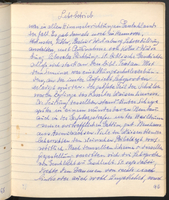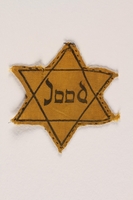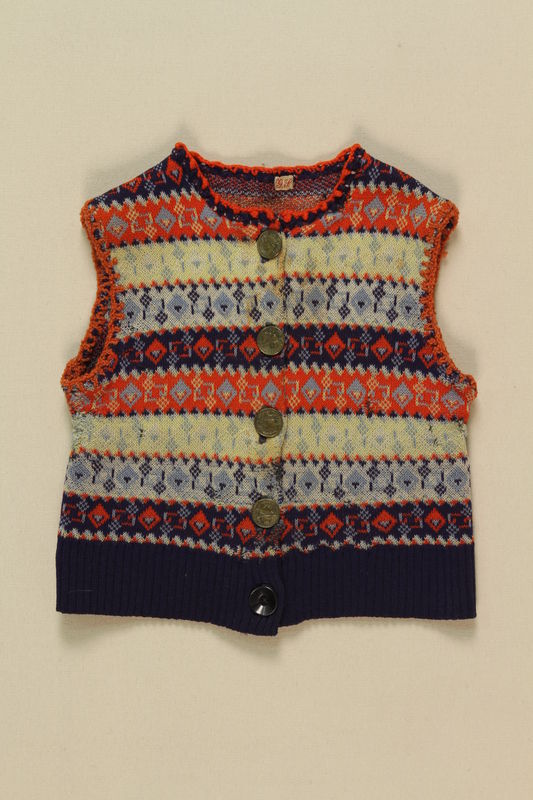Overview
- Brief Narrative
- Striped knit wool vest worn by four year old Truusje Schoenfeld when she was a hidden child in German occupied Netherlands from 1943 to 1945. In May 1940, Amsterdam was occupied by Nazi Germany. In 1943, four year old Truusje and her parents, Walther and Margaretha, were ordered to report for deportation to a concentration camp. A neighbor, Mimi Grimberg da Silva Rosa, a German Protestant, who had hidden Truusje before, found them in the yard where they were being held and told the guard she had left something there. He let her in with her bike and as she went by the family, she picked Truusje up and put her in the basket, then rode out. She placed Truusje in hiding with a loving family outside Amsterdam, the De Bruins, who kept Truusje until the end of the war. Her parents were sent to Auschwitz extermination camp and killed. After the May 1945 liberation of the Netherlands, Mimi came and took Truusje away from the De Bruins. That summer, Truusje's maternal grandfather and uncle, Levi and Werner Katz, returned from Theresienstadt concentration camp. In November 1946, Truusje and her grandfather emigrated to the United States.Amsterdam was occupied by Nazi Germany in May 1940. By 1942, deportations of Jews to concentration camps were frequent and Truusje and her parents, Walther and Margaretha, were ordered to report for deportation in 1943. A neighbor, Mimi Grimberg da Silva Rosa, a German Protestant, rescued Truusje from the yard where they were being held and found her a hiding place with a couple outside of Amsterdam. Walther and Grete were sent to Westerbork internment camp, and then to Auschwitz, where they both were killed. After the Netherlands was liberated by the Canadian Army in May 1945, Truusje lived with Mimi until her maternal grandfather and uncle, Levi and Werner Katz, returned to Amsterdam from Theresienstadt concentration camp.
- Date
-
use:
approximately 1944-1945
- Geography
-
use:
Amsterdam (Netherlands)
- Credit Line
- United States Holocaust Memorial Museum Collection, Gift of Trudy Katzer
- Contributor
-
Subject:
Trudy Katzer
- Biography
-
Geertruida (Truusje) Simone Gittel Schoenfeld was born on July 14, 1939, in Amsterdam, Netherlands, the only child of Walther Isidor and Margareta (Grete) Katz. Walther was born on December 12, 1906, in Kesselbach, Germany, where his parents, Simon and Malchen Katzenstein Schoenfeld, had a farm. He had two brothers, Moritz and Artur. Grete was born on February 27, 1909, in Ottweiler, Germany, to Levi and Berta Wolf Katz. Her father was a cantor and schoolmaster. Grete was the fourth of eight children and the family lived above the school. Following Hitler’s appointment as Chancellor in 1933, Jews were disenfranchised from German society. Walther was expelled from law school around 1935 because he was Jewish. Walther and Grete married in 1936/37 and left for Amsterdam. Grete’s parents and her brother, Werner, also emigrated there. Grete’s siblings, Nora, Siegfried, and Frieda left Germany for Palestine and Kathe, Robert, Ruth, and Lotte went to America. Walther’s brothers and their families emigrated to the United States.
In Amsterdam, Walther sold handbags and worked for the Jewish Council. Grete worked as a milliner. Her mother passed away in 1940 of natural causes. In May 1940, Germany invaded the Netherlands. Jews were soon segregated from Dutch society; many were imprisoned and, after 1942, many were deported to concentration camps. Their neighbor, Mimi Grinberg de Silva Rosa, a German Protestant married to a Portuguese Jew, was active in the Dutch underground. While working at the Jewish Council, Walther was told by a German official that they would not bother Jewish families that stayed together. Grete did not believe this and, in 1943, asked Mimi to hide Truusje as round-ups of Jews increased. Mimi obtained false papers for the family, but Walther would not accept them because he feared he would betray Mimi if he was caught. Around this time, Grete’s father and her brother were sent to Westerbork transit camp, and then deported to Theresienstadt concentration camp. Mimi placed Truusje with a Christian family in the countryside, but she had to be moved back to Amsterdam after she told the neighborhood children that she was Jewish. The night after Truusje returned, the Germans conducted a round-up of Jews and the family was ordered to go to a synagogue. They returned home after their names were not called but, later that night, the Germans raided their apartment and took Walther, Grete, and Truusje to a fenced schoolyard where they were held for deportation transport. Mimi found out where they were and got a marshall in the yard to tell her where the Schoenfeld’s were located. She then told the guards that she had left her wallet there, went over and put Truusje on her bicycle, and rode out of the field. Walther and Grete were sent to Westerbork on the next day, September 7, 1943, and then deported to Auschwitz. Four year old Truusje was placed with a Christian family for several weeks in Amsterdam, until they told Mimi that they would not hide her any longer. Truusje was sent to live with Pedro and Truus De Bruin in the city outskirts. The De Bruins were dark-haired like Truusje and told others that she was their niece from the country. They provided a loving home for Truusje and she stayed with them for the duration of the war. Truusje remembers how she stopped being afraid of airplanes as she and the de Bruin’s watched Canadian planes drop food packets in the yard.
The Netherlands was liberated by the Canadian Army in May 1945. Mimi came to get Truusje who resisted. Mimi had to pry Truusje's arms from around Mrs. De Bruin’s waist. Truusje lived with Mimi, her husband, Theo, and their daughter, Franka. She entered school and began to learn English, but she cried all night in her sleep. Truusje’s grandfather returned in May 1945, but her parents had been killed at Auschwitz not long after arrival. Her grandfather gave her a silver Magen David (Star of David) on a chain and, when he tried to fasten it around her neck, she told him that she would not wear it; she was not a Jew. Soon after this, her maternal uncle, Werner, returned from Thersesienstadt with his wife, Kaatje (Kitty), whom he had married at the camp. Truusje went to live with them for about a year in Utrecht, then Arnhem. It was a difficult arrangement, but Truusje was able to visit Mrs. De Bruin during this time.
In November 1946, she and her grandfather emigrated to the United States via Sweden aboard the SS Gripsholm. In New York, Truusje lived with her maternal uncle and his wife, Siegfried and Gertrude Katz. They adopted her and changed her name to Trudy Katz. Levi moved to Cleveland, Ohio, where one of his daughters lived, but after two years, he moved to Israel and settled in Kibbutz Na’an, where he died at the age of 86. Trudy became a college English professor, married, and had one son.
Physical Details
- Classification
-
Clothing and Dress
- Category
-
Children's clothing
- Object Type
-
Vests (lcsh)
- Physical Description
- Child’s striped machine-knit wool vest with a crew neck and a front opening with French plackets and 4 metal buttons with an embossed portrait and 1 black plastic button. The body is a continuous knit with no seams and has a repeating series of 4 horizontal stripes with geometric patterns: red with black design; yellow with blue; white with blue; dark blue with red. The waistband is dark blue ribbed knit. The neckline has red and blue crocheted trim done with a double blanket stitch and the armholes have red crocheted trim done in a blanket stitch. A cloth nametag is sewn inside the neck.
- Dimensions
- overall: Height: 11.375 inches (28.893 cm) | Width: 9.500 inches (24.13 cm)
- Materials
- overall : wool, metal, plastic, cloth, dye
- Inscription
- inside collar on label, cursive, embroidered, red thread : G. S.
Rights & Restrictions
- Conditions on Access
- No restrictions on access
- Conditions on Use
- No restrictions on use
Keywords & Subjects
- Topical Term
- Hidden children (Holocaust)--Netherlands--Amsterdam--Biography. Holocaust, Jewish (1939-1945)--Netherlands--Amsterdam--Personal narratives. Holocaust survivors--Biography. Jewish children in the Holocaust--Netherlands--Amsterdam--Biography. Righteous Gentiles in the Holocaust--Netherlands--Biography. World War, 1939-1945--Jews--Rescue--Netherlands--Amsterdam--Biography.
Administrative Notes
- Legal Status
- Permanent Collection
- Provenance
- The vest was donated to the United States Holocaust Memorial Museum in 2005 by Trudy Katzer.
- Funding Note
- The cataloging of this artifact has been supported by a grant from the Conference on Jewish Material Claims Against Germany.
- Record last modified:
- 2022-07-28 18:11:11
- This page:
- https://collections.ushmm.org/search/catalog/irn517045
Also in Trudy Katzer collection
The collection consists of a Star of David badge, a child's dress, a child's vest, documents, and photographs relating to the experiences of Truusje Schoenfeld (Trudy Katzer), who was a hidden child in the Netherlands, and her family before, during, and after the Holocaust.
Date: 1936-1959

Trudy Katzer papers
Document
The Trudy Katzer papers contain documents relating to Trudy Katzer and her grandfather, Levi Katz. Included in the papers are memoirs and family histories written by Levi Katz, his refugee card, and his correspondence. Other material includes Trudy’s letters to the family that sheltered her through the war, some photographs of her, and news clippings. The Trudy Katzer papers contain material created by Trudy Katzer and her grandfather, Levi Katz. Most prominent in the collection are four memoirs written by Levi Katz, concerning the history of his life and family. His correspondence contains letters to relatives, from the mayor of his hometown of Borken, and from the Swiss Office of Palestine regarding his immigration. Trudy’s papers include correspondence written to the de Bruins, the family that took her in during the war. There are also photographs of both Trudy, and her mother Margareta, taken at a young age. Also included are news clippings and a prayer book which was given to Walther and Margareta on their wedding day.

Yellow cloth Star of David badge printed with Jood, Dutch for Jew, worn by a German Jewish refugee
Object
Star of David badge used by Truusje Schoenfeld’s family in Amsterdam, Netherlands, during the German occupation. From April 29, 1942, Jews were required to wear a Judenstern on their outer clothing at all times to mark them as Jews. In May 1940, Amsterdam was occupied by Nazi Germany. In 1943, four year old Truusje and her parents, Walther and Margaretha, were ordered to report for deportation to a concentration camp. A neighbor, Mimi Grimberg da Silva Rosa, a German Protestant, who had hidden Truusje before, found them in the yard where they were being held and told the guard she had left something there. He let her in with her bike and as she went by the family, she picked Truusje up and put her in the basket, then rode out. She placed Truusje in hiding with a loving family outside Amsterdam, the De Bruins, who kept Truusje until the end of the war. Her parents were sent to Auschwitz extermination camp and killed. After the May 1945 liberation of the Netherlands, Mimi came and took Truusje away from the De Bruins. That summer, Truusje's maternal grandfather and uncle, Levi and Werner Katz, returned from Theresienstadt concentration camp. In November 1946, Truusje and her grandfather emigrated to the United States.
Prayer book
Object
Prayer book given to Grete (Margarethe) Katz for her wedding in 1936/1937 in Germany. Soon after, Grete and her husband Walther Schoenfled left Nazi-ruled Gemany for Amsterdam, Netherlands. They had a daughter, Truusje on July 14, 1939. In May 1940, Amsterdam was occupied by Nazi Germany. In 1943, Walther and Grete, with four year old Truusje, were ordered to report for deportation to a concentration camp. A neighbor, Mimi Grimberg da Silva Rosa, a German Protestant, who had hidden Truusje before, found them in the schoolyard where they were being held and told the guard she had left something there. He let her in with her bike and as she went by the family, she picked Truusje up and put her in the basket, then rode out. She placed Truusje in hiding with a loving family outside Amsterdam, the De Bruins, who kept Truusje until the end of the war. Walther and Grete were sent to Auschwitz and killed. After the May 1945 liberation of the Netherlands, Mimi came and took Truusje away from the De Bruins. That summer, Truusje's maternal grandfather and uncle, Levi and Werner Katz, returned from Theresienstadt concentration camp. In November 1946, Truusje and her grandfather emigrated to the United States.
Child’s white dress with embroidered flowers and hearts worn by a little girl while living in hiding
Object
Embroidered white dress worn by four year old Truusje Schoenfeld when she was a hidden child in German occupied Netherlands from 1943 to 1945. In May 1940, Amsterdam was occupied by Nazi Germany. In 1943, four year old Truusje and her parents, Walther and Margaretha, were ordered to report for deportation to a concentration camp. A neighbor, Mimi Grimberg da Silva Rosa, a German Protestant, who had hidden Truusje before, found them in the yard where they were being held and told the guard she had left something there. He let her in with her bike and as she went by the family, she picked Truusje up and put her in the basket, then rode out. She placed Truusje in hiding with a loving family outside Amsterdam, the De Bruins, who kept Truusje until the end of the war. Her parents were sent to Auschwitz extermination camp and killed. After the May 1945 liberation of the Netherlands, Mimi came and took Truusje away from the De Bruins. That summer, Truusje's maternal grandfather and uncle, Levi and Werner Katz, returned from Theresienstadt concentration camp. In November 1946, Truusje and her grandfather emigrated to the United States.Amsterdam was occupied by Nazi Germany in May 1940. By 1942, deportations of Jews to concentration camps were frequent and Truusje and her parents, Walther and Margaretha, were ordered to report for deportation in 1943. A neighbor, Mimi Grimberg da Silva Rosa, a German Protestant, rescued Truusje from the yard where they were being held and found her a hiding place with a couple outside of Amsterdam. Walther and Grete were sent to Westerbork internment camp, and then to Auschwitz, where they both were killed. After the Netherlands was liberated by the Canadian Army in May 1945, Truusje lived with Mimi until her maternal grandfather and uncle, Levi and Werner Katz, returned to Amsterdam from Theresienstadt concentration camp.




